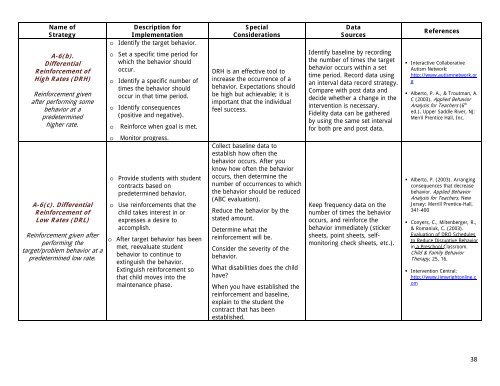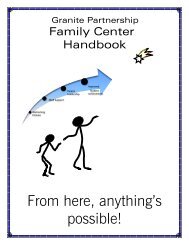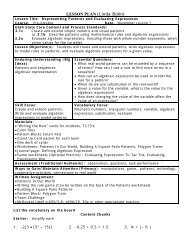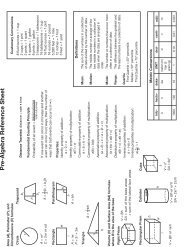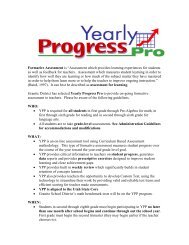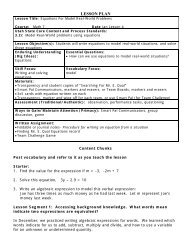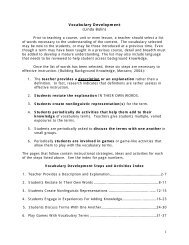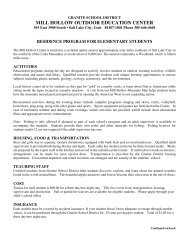Utah's Least Restrictive Behavioral Interventions Guidelines
Utah's Least Restrictive Behavioral Interventions Guidelines
Utah's Least Restrictive Behavioral Interventions Guidelines
You also want an ePaper? Increase the reach of your titles
YUMPU automatically turns print PDFs into web optimized ePapers that Google loves.
Name of<br />
Strategy<br />
A-6(b).<br />
Differential<br />
Reinforcement of<br />
High Rates (DRH)<br />
Reinforcement given<br />
after performing some<br />
behavior at a<br />
predetermined<br />
higher rate.<br />
A-6(c). Differential<br />
Reinforcement of<br />
Low Rates (DRL)<br />
Description for<br />
Implementation<br />
o Identify the target behavior.<br />
o Set a specific time period for<br />
which the behavior should<br />
occur.<br />
o Identify a specific number of<br />
times the behavior should<br />
occur in that time period.<br />
o Identify consequences<br />
(positive and negative).<br />
o Reinforce when goal is met.<br />
o Monitor progress.<br />
o Provide students with student<br />
contracts based on<br />
predetermined behavior.<br />
o Use reinforcements that the<br />
child takes interest in or<br />
expresses a desire to<br />
accomplish.<br />
Reinforcement given after<br />
o After target behavior has been<br />
performing the<br />
met, reevaluate student<br />
target/problem behavior at a<br />
behavior to continue to<br />
predetermined low rate.<br />
extinguish the behavior.<br />
Extinguish reinforcement so<br />
that child moves into the<br />
maintenance phase.<br />
Special<br />
Considerations<br />
DRH is an effective tool to<br />
increase the occurrence of a<br />
behavior. Expectations should<br />
be high but achievable; it is<br />
important that the individual<br />
feel success.<br />
Collect baseline data to<br />
establish how often the<br />
behavior occurs. After you<br />
know how often the behavior<br />
occurs, then determine the<br />
number of occurrences to which<br />
the behavior should be reduced<br />
(ABC evaluation).<br />
Reduce the behavior by the<br />
stated amount.<br />
Determine what the<br />
reinforcement will be.<br />
Consider the severity of the<br />
behavior.<br />
What disabilities does the child<br />
have?<br />
When you have established the<br />
reinforcement and baseline,<br />
explain to the student the<br />
contract that has been<br />
established.<br />
Data<br />
Sources<br />
Identify baseline by recording<br />
the number of times the target<br />
behavior occurs within a set<br />
time period. Record data using<br />
an interval data record strategy.<br />
Compare with post data and<br />
decide whether a change in the<br />
intervention is necessary.<br />
Fidelity data can be gathered<br />
by using the same set interval<br />
for both pre and post data.<br />
Keep frequency data on the<br />
number of times the behavior<br />
occurs, and reinforce the<br />
behavior immediately (sticker<br />
sheets, point sheets, selfmonitoring<br />
check sheets, etc.).<br />
References<br />
• Interactive Collaborative<br />
Autism Network:<br />
http://www.autismnetwork.or<br />
g<br />
• Alberto, P. A., & Troutman, A.<br />
C (2003). Applied Behavior<br />
Analysis for Teachers (6 th<br />
ed.). Upper Saddle River, NJ:<br />
Merril Prentice Hall, Inc.<br />
• Alberto, P. (2003). Arranging<br />
consequences that decrease<br />
behavior. Applied Behavior<br />
Analysis for Teachers. New<br />
Jersey: Merrill Prentice-Hall,<br />
341-400<br />
• Conyers, C., Miltenberger, R.,<br />
& Romaniuk, C. (2003).<br />
Evaluation of DRO Schedules<br />
to Reduce Disruptive Behavior<br />
in a Preschool Classroom.<br />
Child & Family Behavior<br />
Therapy, 25, 16.<br />
• Intervention Central:<br />
http://www.jimwrightonline.c<br />
om<br />
38


